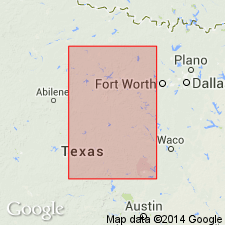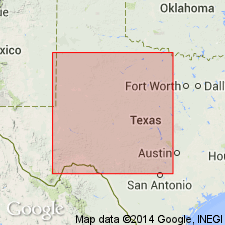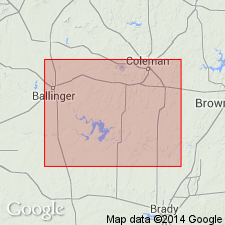
- Usage in publication:
-
- Horse Creek bed
- Modifications:
-
- Original reference
- Dominant lithology:
-
- Limestone
- AAPG geologic province:
-
- Bend arch
Summary:
Pg. 387, 419. Horse Creek bed in Cisco division. Mostly hard massive light-gray limestone, 5 to 15 feet thick, with clay parting in places. Member of Cisco division [Cisco is 2nd from top of 5 Carboniferous divisions of Cummins, 1891]. Underlies Santa Anna bed and overlies Watts Creek bed. Age is Pennsylvanian.
[Named from Horse Creek, Coleman Co., Colorado River region, central TX.]
Source: US geologic names lexicon (USGS Bull. 896, p. 981).

- Usage in publication:
-
- Horse Creek limestone member
- Modifications:
-
- Revised
- AAPG geologic province:
-
- Bend arch
Summary:
Pg. 24, 31; Univ. Texas Bull., no. 2132, p. 177-183 and charts. Horse Creek limestone member of Moran formation (of Cisco group), 5 to 15 feet thick; underlies Santa Anna shale member and overlies Watts Creek shale member of Moran formation in Colorado River Valley, central Texas. [Age is Permian.]
Source: US geologic names lexicon (USGS Bull. 896, p. 981).

- Usage in publication:
-
- Horse Creek limestone member†
- Modifications:
-
- Abandoned
- AAPG geologic province:
-
- Bend arch
Summary:
Pg. 170. †Horse Creek limestone of Drake is preoccupied (see under Strawn formation) and discarded. Moran formation transferred to Wichita group (Permian).
Source: US geologic names lexicon (USGS Bull. 896, p. 981).

- Usage in publication:
-
- Horse Creek formation
- Modifications:
-
- Revised
- AAPG geologic province:
-
- Bend arch
Summary:
Pg. 66 (fig. 1). Horse Creek formation of Moran group. Rank raised to formation in Moran group. Overlies "Dothan" formation; underlies Sedwick formation. Age is Early Permian (Wolfcamp).
Source: US geologic names lexicon (USGS Bull. 1200, p. 1807-1808).

- Usage in publication:
-
- Horse Creek limestone
- Modifications:
-
- Abandoned
- AAPG geologic province:
-
- Bend arch
Summary:
Sheet 2. Name Gouldbusk is here applied to limestone beds and included thin shale that were called Horse Creek limestone by Drake. Sellards (Univ. Texas Bull., no. 3232, 1933) pointed out duplication by Drake in use of this name, as applied to beds in his Strawn division farther east in Colorado River Valley and to limestone, now considered Permian(?) in age, exposed in Coleman County. Sellards restricted application of Horse Creek to beds in Strawn sequence but did not rename the upper beds, which confusingly have continued to be called Horse Creek (Cheney, 1940; King, 1942, AAPG Bull., v. 26, no. 4).
Source: US geologic names lexicon (USGS Bull. 1200, p. 1807-1808).
For more information, please contact Nancy Stamm, Geologic Names Committee Secretary.
Asterisk (*) indicates published by U.S. Geological Survey authors.
"No current usage" (†) implies that a name has been abandoned or has fallen into disuse. Former usage and, if known, replacement name given in parentheses ( ).
Slash (/) indicates name conflicts with nomenclatural guidelines (CSN, 1933; ACSN, 1961, 1970; NACSN, 1983, 2005, 2021). May be explained within brackets ([ ]).

